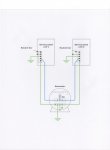There would be current flowing on this conductor because it effectively parallells the neutrals feeding the panels, let's say there's 30 amps unbalanced current in panel 1, panel 2 has a balanced load at 0 amps, since they are effectively paralled, the current would be divided between them, 15 amps would flow on panel 1's neutral, while panel 2, would have 15 amps also. the point that the neutral is jumpered together coming from the generator would also have 15 amps on it. If the receptacle is 30 amp, we would assume the wire size is#10, at this point, the wire will not over heat, but..... if the unbalanced current is increased, say 80 amps (not likely on a single phase 400 amp total size service though) then the current would be 40 amps on that #10 jumper. Then there's the code ramifications of paralleling two different feeders.........Remember, the neutral is considered as a hot wire once it leaves the service disconnect. Would you parallel hots from two different panels?



